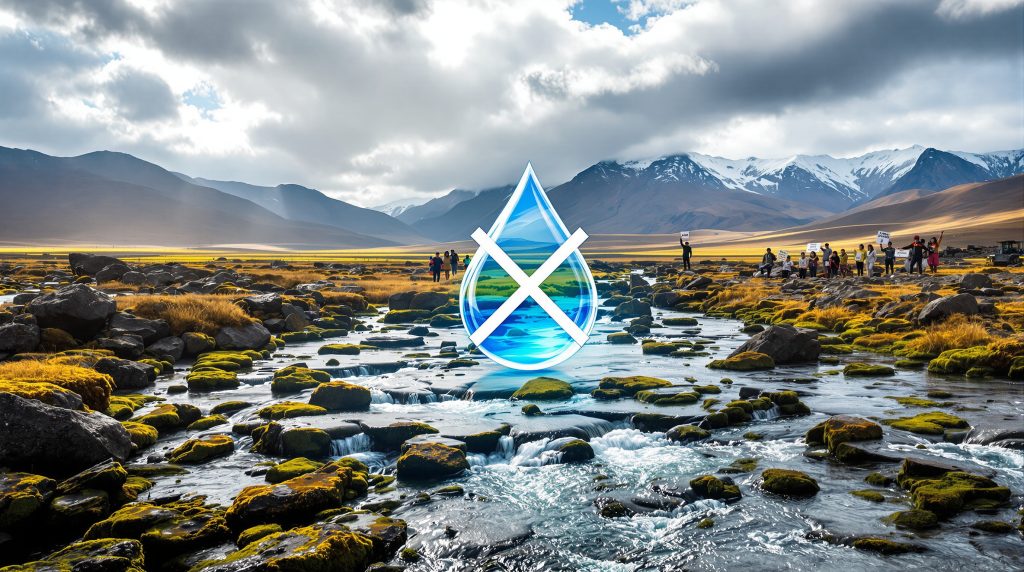Ecuador Revokes Environmental License for DPM Gold Project: Water Protection Prioritized
Ecuador's government has officially revoked the environmental license previously granted to Canadian mining company DPM Metals for its Loma Larga gold project, citing critical concerns about water resource protection. This landmark decision prioritizes environmental conservation over mining development in one of Ecuador's most ecologically sensitive regions.
The revocation follows months of escalating tensions between development interests and environmental protection advocates. Technical assessments from local water management authorities in Cuenca and Azuay provided compelling evidence that mining operations could threaten the region's vital water systems.
Key Factors Behind Ecuador's License Revocation
The decision to revoke the license was largely driven by comprehensive technical reports submitted by authorities in Cuenca and Azuay provinces. These reports highlighted significant risks to drinking water supplies and irrigation systems critical to local communities.
Ecuador's Environment and Energy Ministry emphasized their commitment to "the rights of nature, the defense of water sources, and the protection of health and well-being" of residents in the affected regions. This stance reflects growing recognition of water security as a national priority and demonstrates how the permitting process insights can influence major resource development decisions.
Why Was the Quimsacocha Water Reserve Central to This Decision?
The Quimsacocha Reserve lies at the heart of this environmental decision. Spanning more than 3,200 hectares of pristine Andean highlands, this area represents one of Ecuador's most valuable natural water resources and ecosystems.
The Ecological Significance of Quimsacocha
The Quimsacocha Reserve encompasses a delicate Andean "páramo" ecosystem – a type of highland moor that functions as a natural water collection and filtration system. This specialized ecosystem acts as a massive sponge, absorbing rainfall and gradually releasing it to form springs that serve as major water sources throughout the region.
The páramo's unique vegetation and soil composition allow it to regulate water flow throughout the year, providing consistent water supply even during dry seasons. This natural infrastructure is nearly impossible to replace with engineered solutions, which is why environmental controversy insights often focus on such irreplaceable ecosystems.
Community Dependence on Water Resources
Local communities and economies rely heavily on the Quimsacocha watershed for multiple essential purposes:
- Drinking water supplies for urban centers and rural populations in Cuenca and surrounding areas
- Agricultural irrigation systems supporting local food production and livelihoods
- Ecosystem services maintaining biodiversity and environmental resilience
- Cultural and traditional practices tied to water resources
Local authorities have consistently argued that mining operations would significantly impact water quality and quantity, potentially creating long-term health risks for communities dependent on these resources.
What Was the Scope of the Proposed Loma Larga Project?
The Loma Larga project represented one of Ecuador's most significant potential mining developments, with substantial economic implications for the region and country.
Investment and Production Projections
The proposed mining operation included impressive economic projections:
- Planned capital investment: $419 million
- Projected annual gold production: Approximately 200,000 ounces during first five years
- Additional minerals: Silver and copper extraction planned
- Employment potential: Hundreds of direct and indirect jobs
DPM Metals acquired the project in 2021, positioning it as a cornerstone of their expansion strategy in South America. The company had highlighted the project's economic benefits while asserting their commitment to responsible environmental management.
Project Timeline and Regulatory History
| Date | Development |
|---|---|
| 2021 | DPM Metals acquires the Loma Larga project |
| Mid-2025 | Initial environmental license granted |
| August 2025 | Government suspends project activities pending environmental management plan |
| October 2025 | Environmental license officially revoked |
The rapid regulatory reversal – from granting the environmental license to revoking it within months – demonstrates the evolving nature of environmental policy in Ecuador and serves as a significant mining halt example where regulatory concerns outweigh economic interests.
How Have Stakeholders Responded to the Decision?
The license revocation has generated strong and divided reactions among various stakeholders, highlighting the complex balance between economic development and environmental protection.
Local Government and Community Reactions
Cuenca Mayor Cristian Zamora publicly celebrated the decision at community events, describing it as the culmination of "a decades-long struggle" to protect vital water resources. The mayor emphasized that the project would have "seriously threatened levels of water available for local residents."
Community organizations and environmental advocates have similarly welcomed the government's stance, viewing it as validation of their concerns and a victory for ecological preservation. Many local residents had participated in protests and advocacy campaigns against the mining project for years, as reported by ICMagazine.
DPM Metals' Position and Response
At the time of the announcement, DPM Metals had not issued an immediate public response to the license revocation. However, the company has previously maintained that:
- Their environmental impact studies showed minimal risk to water resources
- The project design incorporated state-of-the-art water protection technologies
- They had fulfilled all regulatory requirements for the environmental license
Mining industry analysts anticipate that DPM may pursue legal remedies, including potential international arbitration, to challenge the decision or seek compensation for investments already made in the project's development, according to Reuters reporting.
What Does This Decision Reveal About Ecuador's Mining Policy?
Ecuador's revocation of the Loma Larga environmental license provides significant insights into the country's evolving approach to natural resource management and environmental governance.
Balancing Development and Environmental Protection
This case demonstrates Ecuador's increasingly complex balancing act between:
- Utilizing mineral resources to drive economic development
- Protecting vital ecosystems and water resources
- Respecting local community perspectives and concerns
- Implementing the "precautionary principle" in environmental decision-making
The government explicitly referenced the precautionary principle in its decision – the approach that when activities may pose serious environmental threats, protective measures should be taken even if some cause-and-effect relationships aren't fully established scientifically.
Broader Context of Mining in Ecuador
Despite possessing significant mineral wealth, Ecuador's mining sector faces considerable challenges:
- Currently, only two large-scale mining companies operate in the country
- Recent legal rulings have halted multiple mining projects throughout Ecuador
- Local opposition and environmental concerns continue to significantly impact regulatory decisions
- Water protection is emerging as a decisive factor in permitting processes
These challenges create a complex investment landscape for mining companies considering Ecuador operations, with regulatory uncertainty presenting a significant risk factor.
What Are the Implications for Future Mining Projects?
The Loma Larga decision establishes important precedents that will likely influence mining development throughout Ecuador and potentially beyond.
Precedent for Environmental Decision-Making
Key precedents established by this case include:
- Environmental concerns, particularly regarding water resources, may override economic development priorities
- Technical assessments from local water authorities can significantly influence national regulatory decisions
- Community opposition can effectively impact high-level policy decisions
- Environmental licenses may be revoked even after initial approval if new concerns emerge
These precedents create a more stringent regulatory framework for future mining projects, especially those near sensitive water resources or protected ecosystems.
Investment Climate Considerations
For mining investors and companies, this decision signals several important shifts:
- Heightened scrutiny of environmental impacts, particularly in water-sensitive regions
- Potential regulatory uncertainty even after permits are secured
- Increased importance of securing genuine community support before significant investment
- Need for more comprehensive water management and protection strategies
Companies considering investments in Ecuador's mining sector will likely conduct more thorough environmental and social impact assessments earlier in their planning processes, with particular attention to water resources and reclamation innovations that can better protect water systems.
How Does This Decision Reflect Global Mining Trends?
Ecuador's prioritization of water resource protection over mining development aligns with emerging global trends in mining regulation and environmental governance.
Water Protection as a Critical Factor
The focus on water protection reflects growing global recognition of:
- Water as a finite and increasingly stressed resource
- The vulnerability of water systems to mining impacts, including contamination and hydrological disruption
- The economic and social value of intact watershed systems
- The challenges of mitigating mining impacts on complex hydrological systems
Mining companies worldwide face increasing scrutiny of their water management practices, with regulatory frameworks increasingly prioritizing watershed protection.
Indigenous and Community Rights
The successful opposition by local communities reflects international movements toward:
- Greater recognition of community consent requirements for resource projects
- Enhanced protection for areas of cultural and ecological significance
- Balancing economic development with environmental justice considerations
- Increasing influence of local perspectives in national resource policies
This trend parallels developments in other mining regions globally, where indigenous and community rights are receiving greater recognition in resource development decisions.
Balancing Resources and Responsibility: A Watershed Decision
Ecuador's decision to revoke DPM Metals' environmental license for the Loma Larga project represents a significant statement about national priorities. By choosing to protect the Quimsacocha water reserve over gold extraction, the government has signaled its commitment to environmental sustainability and community wellbeing.
This case demonstrates the complex challenges facing mining development in ecologically sensitive regions worldwide. As countries navigate the competing demands of economic development, resource extraction, and environmental protection, the Loma Larga decision may serve as an important reference point for balancing these priorities.
The outcome also highlights the growing influence of local communities and environmental advocates in shaping national resource policies. As global demand for minerals continues to rise alongside concerns about environmental impacts, finding sustainable approaches to resource development remains a critical challenge for governments, companies, and communities alike.
Legal and Regulatory Implications
The revocation sets important legal precedents that will influence how environmental licenses are evaluated and potentially revoked in the future. Mining companies operating in Ecuador will need to:
- Conduct more rigorous water impact assessments
- Engage more thoroughly with local communities throughout project planning
- Develop more comprehensive environmental management plans
- Consider regulatory uncertainty as a significant project risk factor
These precedents may extend beyond Ecuador, influencing how other countries approach the regulation of mining in environmentally sensitive areas and driving industry evolution trends toward more stringent environmental protections.
Investment Considerations
For investors considering Ecuador's mining sector, this case highlights several important considerations:
- Regulatory risks may persist even after permits are secured
- Community engagement is essential for project success
- Environmental standards are evolving and becoming more stringent
- Water resource impacts require particularly careful assessment and management
The Loma Larga case demonstrates that environmental concerns can override economic considerations even in regions seeking increased investment and development.
Moving Forward: Sustainable Resource Development
The challenge moving forward will be developing approaches to resource extraction that genuinely protect vital ecosystems while allowing for responsible economic development. This may include:
- More collaborative planning processes involving communities from the earliest stages
- Enhanced technologies for water protection in mining operations
- More comprehensive watershed monitoring systems
- Clearer regulatory frameworks that provide certainty for both communities and investors
The Loma Larga case demonstrates that water protection is no longer optional for mining projects – it has become central to their regulatory approval and social license to operate.
As Ecuador continues to navigate these complex issues, the decision to prioritize water over gold extraction will likely influence resource governance approaches both within the country and beyond its borders.
Want to Stay Ahead of Major ASX Mineral Discoveries?
Discover why mining investments like those discussed in Ecuador can deliver significant returns by exploring Discovery Alert's dedicated discoveries page, where their proprietary Discovery IQ model provides instant notifications on ASX mineral discoveries, turning complex data into actionable insights. Begin your 30-day free trial today at https://discoveryalert.com.au/discoveries/ and position yourself ahead of the market.




